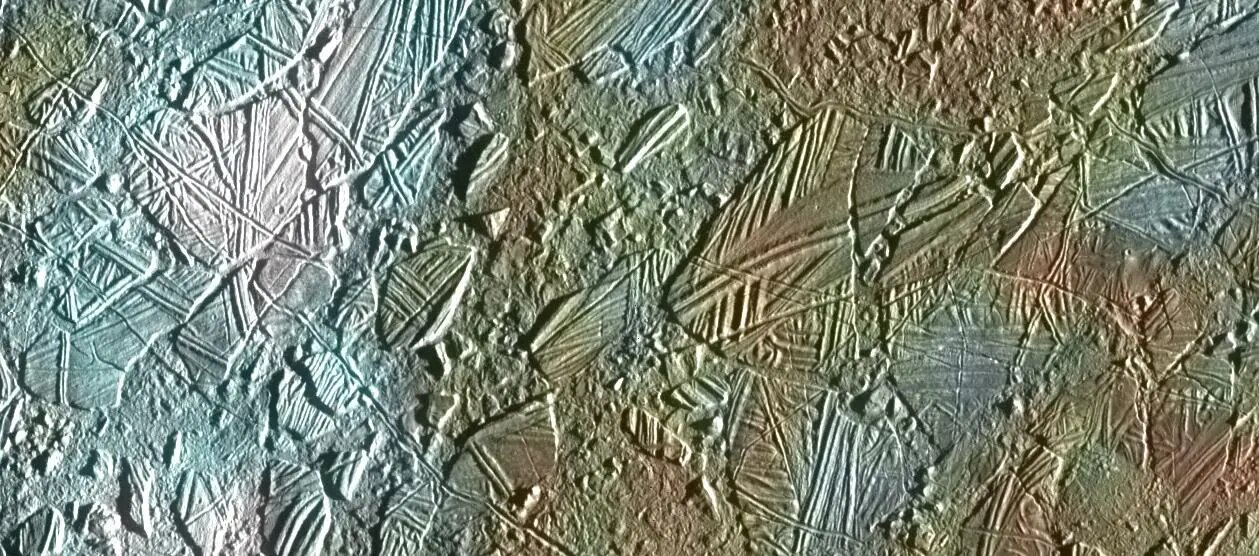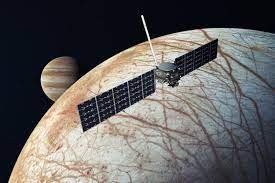Among the dazzling array of celestial bodies dancing around Jupiter, Europa, the sixth-closest moon, holds a special allure. Its smooth, icy surface, scarred by reddish streaks and surprisingly devoid of craters, hints at a dynamic and potentially life-harboring world beneath. This article delves into the captivating world of Jupiter’s Moon Europa, exploring its physical characteristics, the evidence suggesting a hidden ocean, and the upcoming mission that seeks to unveil its secrets.
A World of Ice and Rock
With a diameter of 3,100 kilometers, Jupiter’s Moon Europa is slightly smaller than Earth’s moon. Unlike our familiar moon, its surface is not dominated by craters, but rather by a remarkably smooth landscape. This youthful appearance suggests a geologically active world, where internal processes constantly resurface the icy exterior. Scientists believe Jupiter’s Moon Europa is composed of a rocky core, encased in a thick mantle of water ice, estimated to be over 100 kilometers deep. This icy shell is further adorned by a thin atmosphere, primarily composed of oxygen, likely produced by the interaction of sunlight with the ice surface.
A Realm of Hidden Oceans
While the surface of Jupiter’s Moon Europa presents a captivating spectacle, the true intrigue lies beneath. A plethora of evidence points towards the presence of a vast internal ocean, potentially holding more than twice the volume of Earth’s oceans. This subsurface ocean is believed to be maintained by the tidal forces exerted by Jupiter and its other moons, constantly flexing and stretching Jupiter’s Moon Europa interior. The presence of this ocean is inferred from several observations.
Europa’s magnetic field: Unlike most moons, Jupiter’s Moon Europa exhibits a weak magnetic field, likely induced by interaction with Jupiter’s powerful magnetic field. However, the presence of a salty ocean beneath the ice could contribute to this field, as salty water acts as a conductor.
Surface features: The vast, smooth plains and the presence of long, meandering cracks suggest a dynamic and resurfaced landscape. These features could be a result of past or ongoing eruptions of water from the internal ocean, similar to the plumes observed erupting from Saturn’s moon, Enceladus.
Astronomical observations: Studies using telescopes suggest the presence of water vapor above the surface of Jupiter’s Moon Europa, potentially hinting at plumes erupting from the internal ocean.

The Search for Life on Jupiter’s Moon Europa
The presence of a vast liquid ocean, coupled with the potential for the necessary chemical elements like hydrogen, oxygen, and carbon, makes Jupiter’s Moon Europa one of the most promising candidates in our solar system for harboring potential life. However, the environment within this ocean is likely harsh, characterized by extreme pressure, darkness, and potentially cold temperatures. Life, as we know it, thrives on the delicate balance of these factors. Yet, extremophiles, organisms that thrive in extreme environments on Earth, offer a glimmer of hope. Scientists are actively exploring the possibility of life forms adapted to these harsh conditions, potentially existing in Europa’s subsurface ocean.
Does Jupiter’s moon Europa have oxygen?
While the presence of a potential ocean and essential elements is promising, the availability of oxygen, crucial for life as we know it, remained uncertain. However, a recent study published in Nature Astronomy, led by Jamey Szalay of Princeton University, sheds light on this critical aspect. The study, analyzing data from NASA’s Juno mission, found that Jupiter’s Moon Europa produces about 13 to 40 pounds of oxygen per second, lower than previous estimates but still significant. This oxygen is created through the breakdown of frozen water molecules on Europa’s surface due to bombardment by charged particles from space.
While this research provides valuable insights, key questions remain:
- How much of this oxygen reaches the ocean below?
- How does it interact with the icy crust?
Future missions aim to address these questions:
The European Space Agency’s Jupiter Icy Moons Explorer (JUICE) and NASA’s Europa Clipper mission are specifically designed to investigate Europa’s habitability and provide further insights into its potential for life.
The Europa Clipper Mission

To unravel the secrets of Jupiter’s Moon Europa and assess its potential for life, NASA’s ambitious Europa Clipper mission is scheduled for launch in 2024. This sophisticated spacecraft, equipped with an array of scientific instruments, will embark on a multi-year journey to Jupiter, reaching its orbit in the early 2030s. Once in position, Europa Clipper will perform a series of flybys, studying the moon’s composition, internal structure, and surface features in unprecedented detail. The mission aims to investigate:
- The composition of the surface of Jupiter’s Moon Europa and its potential connection to the internal ocean.
- The nature and extent of the internal ocean of Jupiter’s Moon Europa, including its depth and salinity.
- The presence and characteristics of any plumes erupting from the ocean, potentially provide samples of the ocean’s composition.
- The existence of a magnetic field and its interaction with Jupiter’s magnetic field.
The data collected by Europa Clipper will be crucial in determining the habitability of Europa’s ocean and its potential to harbor life. The mission holds the potential to revolutionize our understanding of this captivating moon and its place in the search for life beyond Earth.
Despite the challenges, scientists remain optimistic about unraveling the mysteries surrounding Europa’s potential for life. Data from Juno’s flyby marks an exciting step forward, and future missions like JUICE and Europa Clipper promise to reveal more about this captivating moon. With continued exploration, we may soon unlock the secrets hidden beneath Jupiter’s Moon Europa icy veil and answer the age-old question: Are we alone in the universe?





